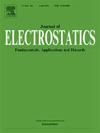Mathematical identities for the electrostatic potential of a uniformly charged ring: A rigorous proof
IF 1.9
4区 工程技术
Q3 ENGINEERING, ELECTRICAL & ELECTRONIC
引用次数: 0
Abstract
We show a rigorous mathematical proof of some mathematical identities that were uncovered during studies of the electrostatic potential generated by a uniformly charged ring. The authors in Ciftja et al., (2009) presented two independent expressions for this potential on the plane of the ring: one derived using complete elliptic integrals and the other one obtained through an integral involving Bessel functions. By asserting the equivalence of these two expressions they proposed a remarkable identity that connects integrals of products of Bessel functions with complete elliptic integrals of the first kind. However, they were unable to provide a formal mathematical proof of these results. The goal of this paper is to fill this gap by presenting a rigorous and detailed derivation of these mathematical identities. To accomplish this task, we employed standard transformations from the theory of special functions. The key steps in the proof include rewriting the Bessel integral representation of the potential in terms of the Legendre function of the second kind and subsequently expressing it in terms of the complete elliptic integral via known transformations. By establishing the exact equivalence between the Bessel-based and complete elliptic integral-based formulations of the problem, we not only can prove the proposed identities, but also reinforce their relevance for future applications in electrostatics and mathematical physics. These results demonstrate the deep connections that exist among various special functions and highlight the importance of rigorous analysis in validating assumptions made in earlier theoretical work.
均匀带电环静电势的数学恒等式:严格的证明
我们展示了一些数学恒等式的严格数学证明,这些恒等式是在研究由均匀带电环产生的静电势时发现的。Ciftja et al.,(2009)的作者在环平面上给出了该势的两种独立表达式:一种是用完全椭圆积分推导出来的,另一种是通过涉及贝塞尔函数的积分得到的。通过断言这两个表达式的等价性,他们提出了一个显著的恒等式,将贝塞尔函数积的积分与第一类完全椭圆积分联系起来。然而,他们无法为这些结果提供正式的数学证明。本文的目标是通过提出这些数学恒等式的严格和详细的推导来填补这一空白。为了完成这个任务,我们采用了特殊函数理论中的标准变换。证明的关键步骤包括用第二类勒让德函数重写势的贝塞尔积分表示,然后通过已知变换用完全椭圆积分表示。通过建立基于贝塞尔和完全椭圆积分的方程之间的精确等价性,我们不仅可以证明所提出的恒等式,而且可以加强它们在未来静电学和数学物理中的应用。这些结果证明了各种特殊函数之间存在的深层联系,并强调了在验证早期理论工作中所做假设的严格分析的重要性。
本文章由计算机程序翻译,如有差异,请以英文原文为准。
求助全文
约1分钟内获得全文
求助全文
来源期刊

Journal of Electrostatics
工程技术-工程:电子与电气
CiteScore
4.00
自引率
11.10%
发文量
81
审稿时长
49 days
期刊介绍:
The Journal of Electrostatics is the leading forum for publishing research findings that advance knowledge in the field of electrostatics. We invite submissions in the following areas:
Electrostatic charge separation processes.
Electrostatic manipulation of particles, droplets, and biological cells.
Electrostatically driven or controlled fluid flow.
Electrostatics in the gas phase.
 求助内容:
求助内容: 应助结果提醒方式:
应助结果提醒方式:


